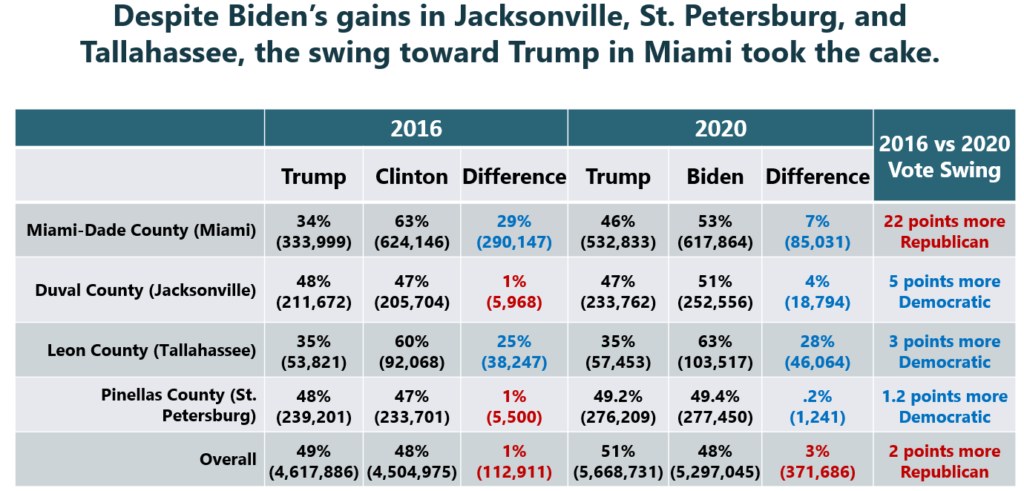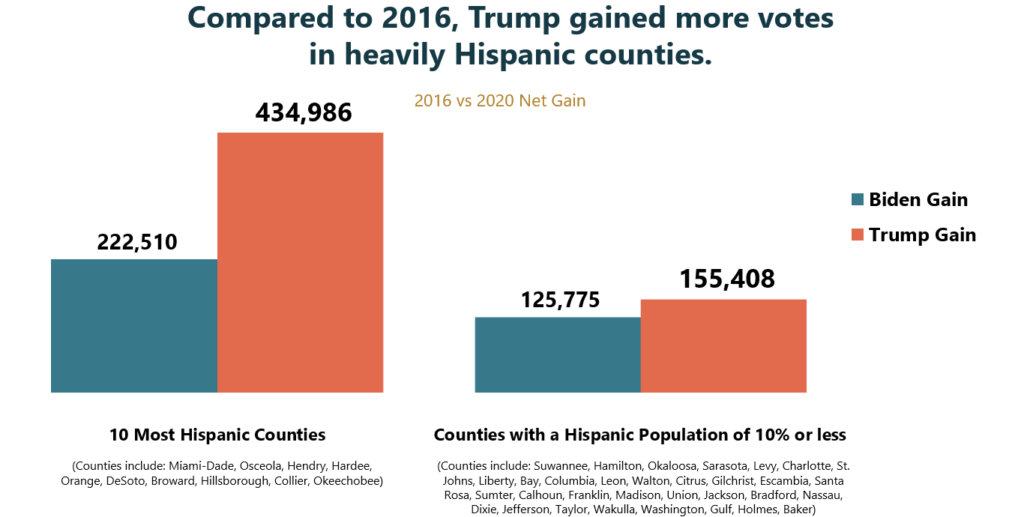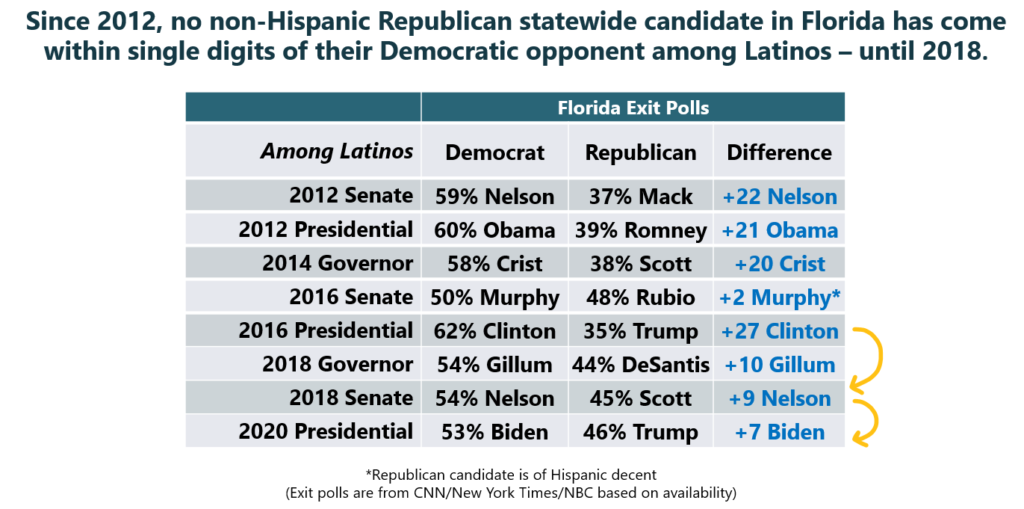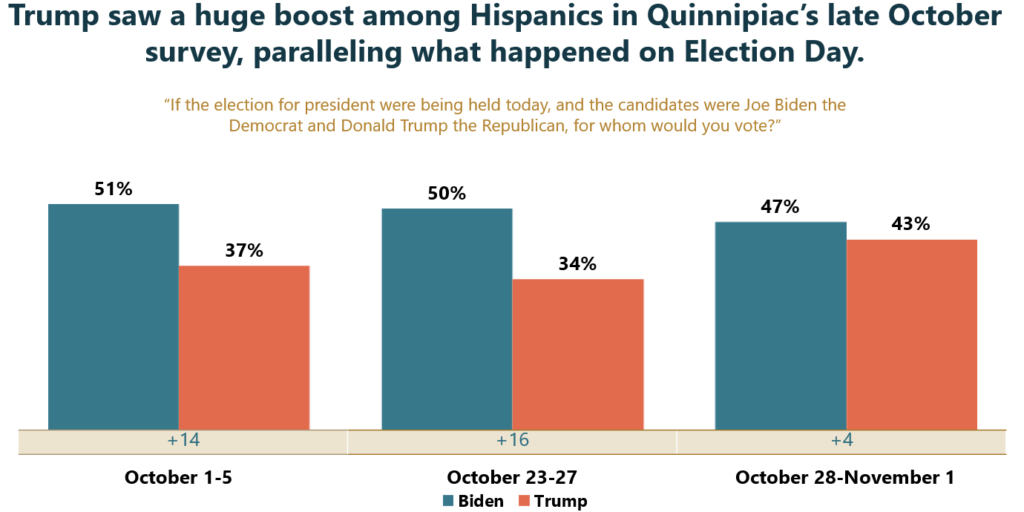featured insight
featured insight

Democrats, Republicans, and the Sunshine State
If you were watching the 2020 Election Night coverage, chances are Florida was a hot topic, especially what was happening in Miami-Dade County at the very bottom of the state.
Heading into Election Day, FiveThirtyEight’s polling average in Florida showed Joe Biden with a slight edge (+ 2.5 points); but, by the time all the votes were counted, Donald Trump won the state by three points and received over a million more votes than he did in 2016. How did this happen?
Bienvenidos a Miami. Miami-Dade is Florida’s most populous county, and it’s home to nearly one-third of Florida’s Hispanic population as almost seven out of every ten residents in Miami-Dade are Hispanic.
Contrary to that Will Smith song from the 90s, for Democrats, election night was anything but a party (come on, you know the words . . . “Party in the city where the heat is on / All night on the beach till the break of dawn / ‘Welcome to Miami’”). Let’s look at what happened in the county, how it compares to other parts of the state, and what it might mean for elections in the years to come.
Trump Made Big Gains in Miami-Dade County
While President Trump was taking on water in other parts of the country, even other parts of Florida, the story coming out of Miami-Dade was quite different. In 2016, Hillary Clinton won Miami-Dade by almost 30 percentage points. In contrast, Biden’s margin in Miami-Dade was shockingly narrow, winning the county by only 7 points. That means Miami-Dade voted 22 percentage points more Republican at the Presidential level than it did in 2016.
More pointedly, Trump received a whopping 198,834 more votes in Miami-Dade than his 2016 run while Biden received 6,282 fewer votes than Hillary Clinton. Put another way, out of 67 total counties in Florida, Miami-Dade was one of only four where Biden underperformed Hillary Clinton.
Shortly after midnight, the results in Miami-Dade led to Florida being called for Donald Trump. In addition, Republicans secured two big wins in South Florida congressional seats, both of which were rated as lean or likely Democrat. These results came despite Biden flipping key counties like Duval (Jacksonville) and Pinellas (St. Petersburg) and increasing the 2016 Democratic vote share in places like Tallahassee. But those results couldn’t outdo what went down in Miami.

The Hispanic Vote in Miami-Dade County Swung toward Trump
This could not have happened without Hispanics. According to exit polls from 2016, Trump lost Latino voters in Florida by 27 points. After the election, Trump began ardently courting Florida Hispanics, tying Democrats to socialism by pointing to the extreme socialist rhetoric coming from likes of AOC, Bernie Sanders, and other proud party progressives. Fast forward to 2020, and he lost Latino voters by a mere 7 points.
Although Most Pronounced in Miami-Dade, this Swing Happened Throughout Florida
Compared to 2016, Trump gained about 435,000 votes in Florida’s 10 most Hispanic counties. Biden, however, only gained roughly 223,000 more than Clinton in 2016 – meaning Trump gained roughly 212,000 more votes than Biden did.
On the other hand, in Florida’s least Hispanic counties (10% Hispanic or less), Trump garnered 155,000 more votes than his 2016 run while Biden earned 126,000 more than Clinton did in 2016 – a much narrower 30,000 vote difference.

While some Democrats like to dismiss accusations of socialism from the right as laughable, the reality seems to be that this message struck a chord with Cuban, Venezuelan, and other Latino immigrants who fled the misery and oppression of socialist regimes run by Chávez, Castro, and Maduro not all that long ago.
And while Trump and down-ballot Republicans were busy tying Biden and other Democrats to a radical socialist agenda, Democrats did little to combat that message. Ultimately, that strategy backfired and was a case of too little, too late.

As you’d expect, this left many caught off guard as Florida’s results rolled in. However, the signs were there if one just took the time to look.
Signs of this Shift Began in the 2018 Florida Midterms
As alluded to earlier, Trump began courting Florida Hispanics in 2016, and that strategy started to pay off in the 2018 midterms. During that election, Senator Rick Scott and Governor Ron DeSantis, both Republicans, won statewide races in Florida despite Democrats gaining a net 41 congressional seats nationally and flipping control of the U.S. House of Representatives.
Looking at the exit polls, Scott only lost Latinos by nine points and DeSantis lost them by ten. That’s quite a difference from the 27 points Trump lost them by just two years prior. In fact, since 2012, no non-Hispanic Republican statewide candidate in Florida has managed to get within single digits of their Democratic counterpart among Latinos until Rick Scott’s 2018 Senate win.

Leading to the 2020 Election, Polls Showed Trump Gaining Ground with Hispanics in Florida
Furthermore, Quinnipiac University’s last three public polls in Florida show a clear trend. In early October, Quinnipiac data has Biden +14 among Hispanics. Just prior to Election Day, however, he is only polling plus four.

Bottom line, the signs were undoubtedly there – perhaps just a little hard to believe.
Looking Forward to 2022
As we look ahead to the 2022 midterms, Florida will once again be a top priority for both parties as Republican Governor Ron DeSantis and Republican Senator Marco Rubio will face competitive reelection bids. And you can bet Republicans will continue their strategy of tying Democrats to socialism as they appeal to Hispanic voters in Florida. So while Democrats continue to wrestle with progressives who want to take the party more to the left, they’re also wrestling with what that means for the future of Florida as the Sunshine State may very well hang in the balance.

